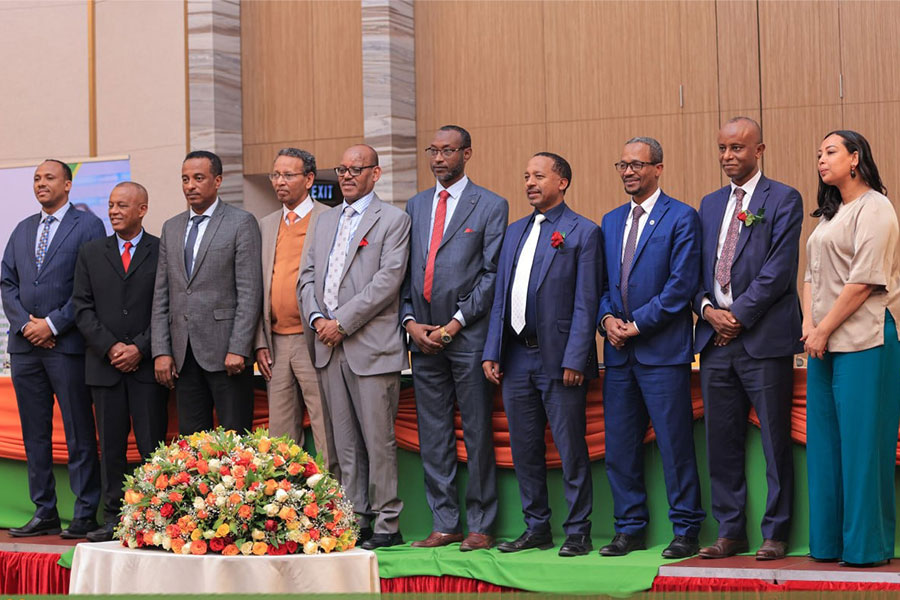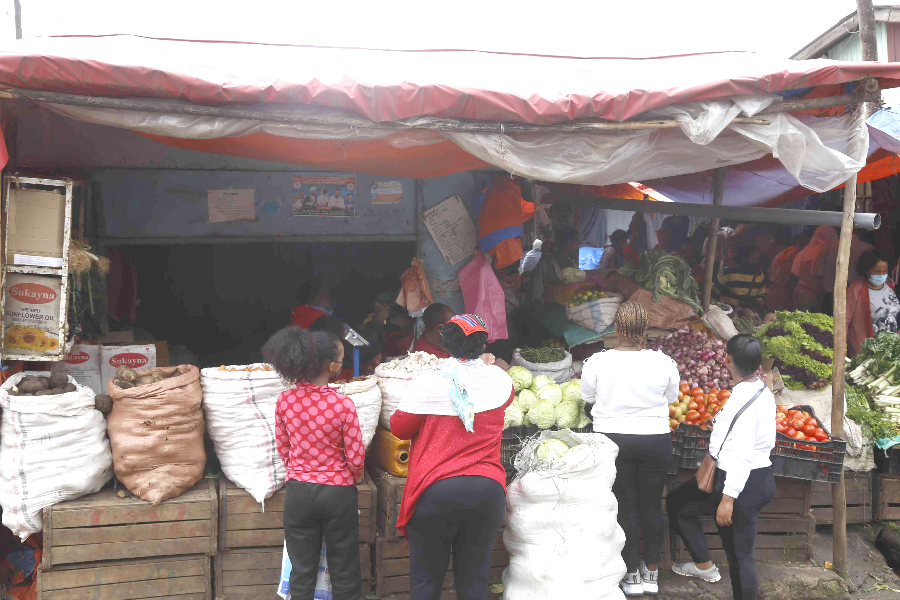
Radar | Jul 08,2023
Oct 1 , 2022
By Tsegaye Yilma (PhD)
The government’s effort to prove the country’s potential to produce irrigated wheat is commendable. It is an excellent proof of concept that now needs to be given time to take root and be led by the private sector with strong government support, writes Tsegaye Yilma (PhD) (tsegayey@gmail.com), an entrepreneur and development financing professional with more than a decade of experience in the community development financing industry in the US.
The report about Ethiopia’s potential to produce irrigated wheat is a source of hope for a country stigmatised with food aid dependence. This fascinating development took me back about two decades to a research paper my colleague and I presented at an international conference on the Ethiopian economy.
Titled, "Small Holder Irrigation and its Challenges in Ethiopia's Food Security Agenda: Lessons from Ghana," the paper pointed out that Ethiopia’s irrigation schemes could not contribute to food security because they were small and focused on vegetable production. We argued that for irrigation to contribute to Ethiopia's food security, it needs to prioritise cereal production, and we recommended investment in large-scale irrigation schemes which integrate smallholder farmers.
We shared our research experience in Northern Ghana, where the government subdivided a large-scale irrigation scheme and leased it to smallholder rice producers. It is heartwarming to see Ethiopia similarly experimenting with larger-scale irrigation schemes involving smallholder farmers and targeting cereal production.
In 2021/22, Ethiopian farmers cultivated 2.3 million hectares of wheat, and irrigated wheat contributed 26pc, a significant milestone for a country without a history in irrigated wheat production. The year before, 5.5 million tonnes of wheat were produced, and more than one million tonnes were imported at a cost of 431 million dollars, according to the Food & Agriculture Organisation (FAO). With a conservative productivity estimate of three tonnes a hectare, the 600,000hct of irrigated wheat will yield 1.8 million tonnes, almost twice what the country imported in 2020.
Although there is no consensus regarding Ethiopia's ability to produce wheat on a scale that can make a dent, on its face, Ethiopia should be able to substitute imports in a few years. On June 16, 2022, a Bloomberg report quoted the US Department of Agriculture's statement that Ethiopia's attempt to stop wheat imports by 2023 with "limited resources to adopt necessary technologies" is a "very unrealistic and unachievable target."
Whether Ethiopia could achieve these ambitious goals can be debatable, however, it is evident that it has proved its potential. The question should instead be what conditions need to be in place to make irrigated wheat production sustainable and an integral part of Ethiopia’s agricultural production system.
Sustainability is the ability of a system to continue producing without creating environmental, social, and economic havoc. For Ethiopia’s irrigated wheat production, this means recognising the learning curve for farmers to adopt the new practice, while the physical and socio-economic systems are afforded time to adjust. It is essential to acknowledge that the 600,000hct of irrigated wheat did not happen in a vacuum. It competed for the country’s limited foreign currency to import fertiliser and other agricultural inputs, labour, water, and government budget. Thus, the country needs to evaluate the current irrigated wheat production performance to learn what has worked and did not before committing resources for any expansion.
For perspective, it is important to remember that the current Ethiopian rainfed agricultural system is a result of hundreds, maybe thousands, of years of trial and error. The government needs to leave the irrigation decision to the farmers and focus on creating a conducive business environment and refrain from putting quotas. Quota put pressure on development agents and local cadres to intimidate unprepared and unconvinced farmers into irrigated farming, resulting in a mediocre performance and pushback against the new technology.
Ethiopia has ample history of well-intentioned quotas and “Zemechas” that ended badly. They should not have any place in the new system if we want irrigated wheat production to become part and parcel of the country’s agricultural system.
The guiding principle for a farmer’s participation in the irrigation system should be willingness and readiness to farm rather than owning a plot of land within the irrigation scheme. For most farmers, irrigated wheat production is second-season farming immediately following the rain season's hard work. Some farmers, who have plots of land in the irrigated system, may not be able or ready to farm either due to economic or social engagement planned for the summer season. These farmers need to have the choice to farm, lease out, or partner with other individuals who can contribute capital and labor.
Such flexibility will help attract only ready and committed farmers, resulting in high productivity and sustainable production without putting a financial burden on land-owning farmers. The government could support the joint farming or the lease-out option by initiating a strong contract law, establishing local business courts that handle contract disputes, putting punitive measures to disincentivise contract violations, and timely enforcing court orders.
Intentionality in creating the necessary linkages with different market players is another element that will contribute to the sustainability of irrigated wheat production. Establishing a solid link with businesses such as agro-industries, bread factories, and animal feed processing plants can provide wheat production with the necessary logistical support, such as storage, transportation, and processing capability.
From 25pc to 30pc of the products from a wheat milling process are wheat by-products used for livestock consumption, according to Kansas State University research. That means Ethiopia’s 1.8 million tonnes of irrigated wheat production will provide about 0.45 million tonnes of animal feed which is a consequential contribution to the country’s animal feed industry. The government can strengthen these linkages by providing technical assistance and facilitating credit and financial support.
Suppose Ethiopia's dream to be a wheat exporter comes to fruition. In that case, a deliberate effort must be made to make the irrigated wheat production system the first beneficiary of the generated foreign currency. It can be used to import fertiliser, chemicals, machinery, and spare parts required for irrigated wheat production.
However, the practicality of wheat export calls for answers to questions such as: where is Ethiopia’s export market? What will make Ethiopian wheat competitive in the international market? What are the health and quality requirements in the global wheat market, and does Ethiopia have the expertise and the infrastructure to meet the export standards?
In all this, if Ethiopia achieves sustainable irrigated wheat production, the government's primary responsibility should be to have a strategy for an equitable distribution of wheat to all parts of the country. It will be disgraceful if Ethiopia brags about exporting wheat from its irrigation schemes while it receives wheat from USAID and the World Food Programme (WFP) to feed millions of hungry citizens. The primary goal should be to graduate from international food aid dependency, a stigma we have been carrying for decades. I hope this is the beginning of our national journey to thank the world for feeding us so far and show them that we are now able to feed ourselves.
The government’s effort to prove the country’s potential to produce irrigated wheat is commendable. It is an excellent proof of concept that now needs to be given time to take root and be led by the private sector with strong government support. This will be a national journey where we know that we reached our destination only when we improve the livelihood of our farmers, provide the urban poor with an affordable loaf of bread, and when Ethiopia graduates from being a foster child of international food aid. Until then, it is too soon to boast about our achievements.
PUBLISHED ON
Oct 01,2022 [ VOL
23 , NO
1170]


Radar | Jul 08,2023

Radar | Aug 22,2020

Radar | Jul 31,2021

Fortune News | Mar 28,2020

Viewpoints | Jun 07,2020

Commentaries | May 31,2025

Viewpoints | Nov 23,2024

Viewpoints | Feb 05,2022

Radar | Mar 20,2021

Radar | Jul 30,2022

My Opinion | 132041 Views | Aug 14,2021

My Opinion | 128437 Views | Aug 21,2021

My Opinion | 126364 Views | Sep 10,2021

My Opinion | 123983 Views | Aug 07,2021





Dec 22 , 2024 . By TIZITA SHEWAFERAW
Charged with transforming colossal state-owned enterprises into modern and competitiv...

Aug 18 , 2024 . By AKSAH ITALO
Although predictable Yonas Zerihun's job in the ride-hailing service is not immune to...

Jul 28 , 2024 . By TIZITA SHEWAFERAW
Unhabitual, perhaps too many, Samuel Gebreyohannes, 38, used to occasionally enjoy a couple of beers at breakfast. However, he recently swit...

Jul 13 , 2024 . By AKSAH ITALO
Investors who rely on tractors, trucks, and field vehicles for commuting, transporting commodities, and f...

Jul 12 , 2025
Political leaders and their policy advisors often promise great leaps forward, yet th...

Jul 5 , 2025
Six years ago, Ethiopia was the darling of international liberal commentators. A year...

Jun 28 , 2025
Meseret Damtie, the assertive auditor general, has never been shy about naming names...

Jun 21 , 2025
A well-worn adage says, “Budget is not destiny, but it is direction.” Examining t...

Jul 13 , 2025 . By YITBAREK GETACHEW
The Addis Abeba City Revenue Bureau has introduced a new directive set to reshape how...

Jul 13 , 2025 . By BEZAWIT HULUAGER
Addis Abeba has approved a record 350 billion Br budget for the 2025/26 fiscal year,...

Jul 13 , 2025 . By RUTH BERHANU
The Addis Abeba Revenue Bureau has scrapped a value-added tax (VAT) on unprocessed ve...

Jul 13 , 2025 . By NAHOM AYELE
Federal lawmakers have finally brought closure to a protracted and contentious tax de...